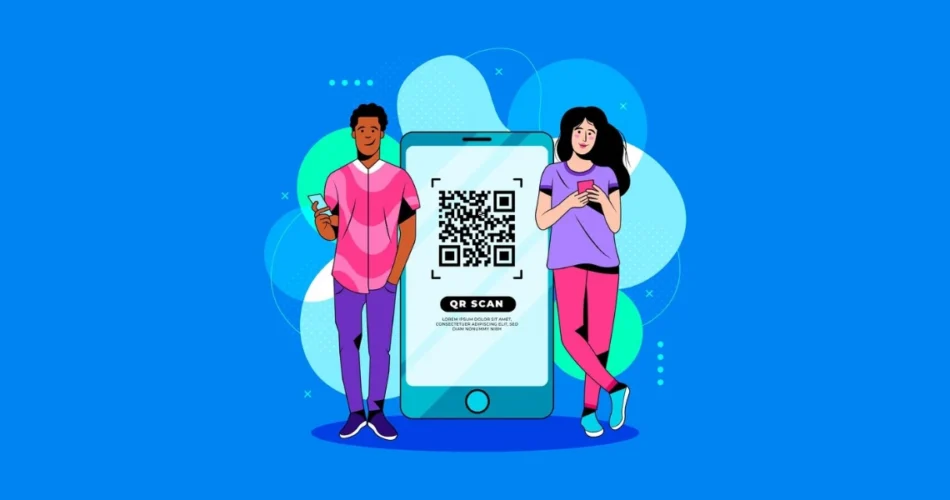QR Codes and marketing. These two terms would not have been in the same sentence when QR Codes were created.
But now, the times have changed.
These matrix barcodes allow marketers to effortlessly connect with consumers through their smartphones.
QRs facilitate instant access to digital content, promotions, product information, and interactive experiences.
If you want to know how to use QR Codes in marketing, you have come to the right place.
Let’s take a deep dive together to learn more about it!
A. Setting objectives: Defining your marketing goals with QR Codes

Setting objectives and defining clear marketing goals with QRs is essential for ensuring the success of your campaigns.
Here are some key things to follow:
1. Begin by identifying your marketing goals with QRs, such as increasing brand awareness, driving website traffic, boosting sales, or enhancing customer engagement.
2. Ensure that each goal is specific, measurable, attainable, relevant, and time-bound (SMART).
3. Tailor your QR strategies to align with these objectives, considering your target audience’s preferences and behaviors.
4. Create compelling calls to action and offer valuable incentives to encourage QR interaction.
5. Integrate tracking mechanisms into your QR campaigns to measure their performance effectively.
6. Analyze key metrics like scan rates, conversion rates, and customer demographics to evaluate the success of your campaigns.
7. Make data-driven decisions for improvement based on campaign performance insights.
8. Continuously refine your QR initiatives to ensure they remain aligned with your overarching marketing goals and drive meaningful results for your business.
B. Integrating QR Codes across marketing channels
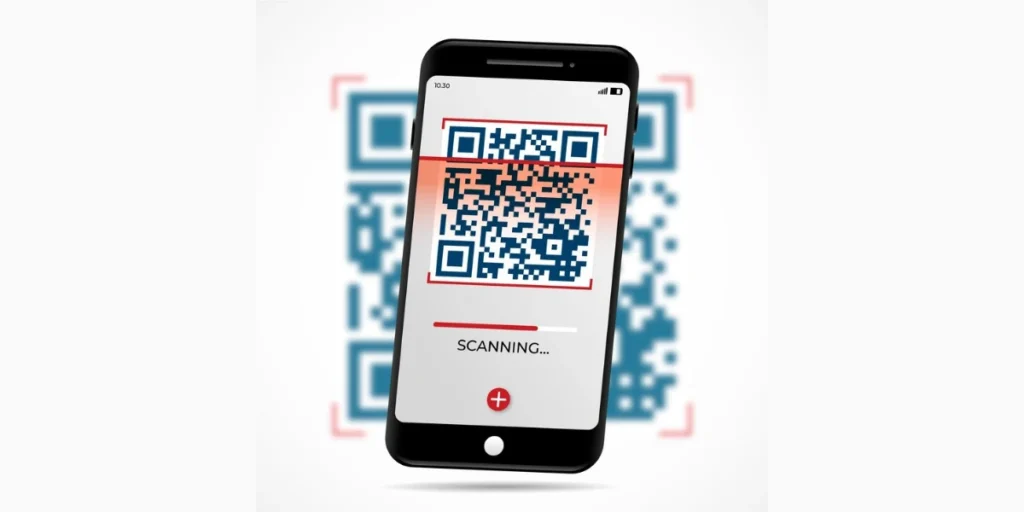
Integrating QRs across marketing channels is a strategic approach that maximizes their effectiveness in reaching and engaging target audiences.
Here’s how to leverage QRs seamlessly across various channels:
1. Print materials
Incorporate QRs into printed materials such as brochures, flyers, posters, and business cards to provide instant access to additional information, promotional offers, or multimedia content.
2. Packaging
Enhance product packaging with QRs to offer product details, usage instructions, customer reviews, or loyalty program sign-ups, providing value to consumers at the point of purchase.
3. Digital marketing
Use QRs in email campaigns, social media posts, and digital advertisements to drive traffic to specific landing pages, encourage app downloads, or facilitate online purchases.
4. In-store signage
Display QRs on in-store signage, window decals, or shelf tags to promote special offers, product demonstrations, or customer reviews, guiding shoppers to relevant digital content while they browse.
5. Events and tradeshows
Integrate QRs into event materials such as banners, badges, or promotional merchandise to facilitate attendee registration, access event agendas, or connect with exhibitors, enhancing the overall event experience.
Read how QR Codes are helping marketers
6. Direct mail
Include QRs in direct mail campaigns to drive recipients to personalized landing pages, exclusive offers, or interactive experiences, increasing engagement and response rates.
7. Point-of-sale (POS) materials
Embed QRs in POS displays, receipts, or checkout counters to encourage repeat purchases, collect customer feedback, or enroll in loyalty programs, fostering customer retention and satisfaction.
8. Public transportation
Use QRs in advertisements, posters, or digital screens in public transportation hubs to promote destination guides, tourism activities, or mobile ticketing options, catering to commuters and travelers on the go.
C. Creating compelling calls to action for QR Code

Crafting compelling calls to action (CTAs) is essential for driving engagement and maximizing the effectiveness of QR campaigns.
Here’s how to create CTAs that prompt action and encourage QR interaction:
1. Be clear and specific
Communicate the benefit or value proposition of scanning the QR. Use concise language to convey what users can expect upon scanning, whether it’s accessing exclusive content, claiming a discount, entering a contest, or learning more about a product.
For example, Scan the QR for a chance to win exclusive goodies, or scan the QR to avail 30% discount.
2. Use action verbs
Employ action-oriented language that prompts users to take immediate action. Start your CTA with strong verbs like “Scan,” “Discover,” “Unlock,” “Get,” “Access,” or “Try,” compelling users to engage with the QR.
3. Create a sense of urgency
Instill a sense of urgency to prompt immediate action. Incorporate time-sensitive language such as “Limited Time Offer,” “Act Now,” or “Don’t Miss Out,” motivating users to scan the QR promptly to avoid missing out on the opportunity.
4. Offer incentives
Provide enticing incentives or rewards to incentivize QR interaction. Whether it’s a discount, freebie, exclusive content, or entry into a giveaway, clearly highlight the benefits users will receive for scanning the QR.
Here’s what our customers have to say about Scanova:
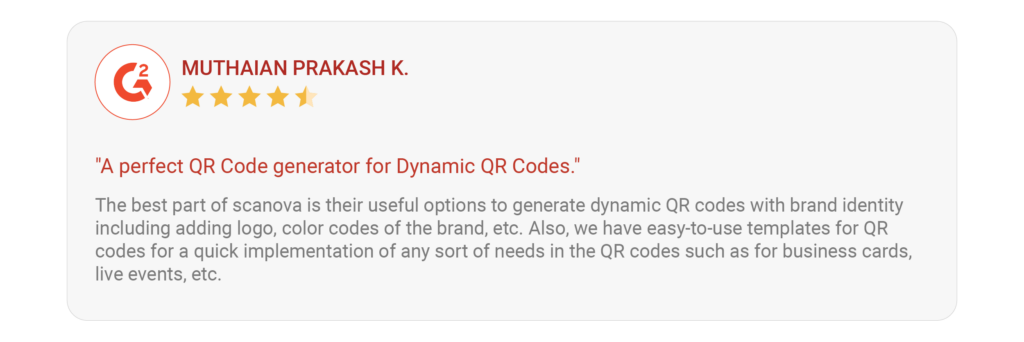
5. Make it personalized
Tailor your CTAs to resonate with your target audience’s interests, needs, and preferences. Personalization can increase relevance and appeal, prompting users to feel a stronger connection to the CTA and compelling them to scan the QR.
Tailoring CTAs to resonate with your audience is vital for boosting engagement. For example, if marketing a meal delivery service to busy professionals, use CTAs like “Get Healthy Meals Delivered!” for convenience.
Addressing health enthusiasts with “Discover Gourmet Options!” or time-pressed individuals with “Save Time, Eat Well!” ensures personalized appeal. Aligning CTAs with specific interests, needs, and preferences enhances relevance and encourages QR scans, fostering stronger connections and driving conversions.
6. Include a call to action
Explicitly instruct users on what action to take after scanning the QR. Whether it’s “Scan to Shop Now,” “Scan to Learn More,” or “Scan to Get Your Free Gift,” provide a clear directive that guides users on the next steps.
7. Optimize design and placement
Ensure that your CTA stands out visually and is prominently displayed alongside the QR. Use contrasting colors, bold typography, or graphical elements to draw attention to the CTA and make it easily recognizable.
8. Test and iterate
Experiment with different CTAs and track their performance to identify which ones resonate most effectively with your audience. A/B testing can help refine your CTAs over time, allowing you to continuously optimize and improve your QR campaigns.


D. Real-world examples of successful QR Code marketing campaigns
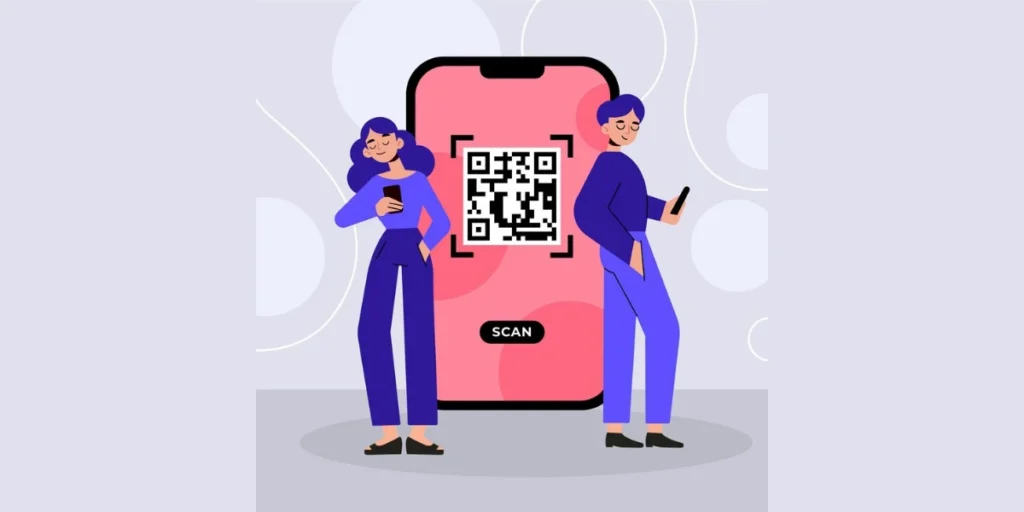
1. Heinz Ketchup’s “Guess the Ingredient” Campaign
Heinz utilized QRs on their ketchup bottles, inviting consumers to scan and participate in a “Guess the Ingredient” game. Scanning the QR directed users to a mobile site where they could input their guesses for a chance to win prizes. This campaign successfully engaged consumers, encouraged repeat purchases, and generated buzz around the brand.
2. Macy’s backstage QR Code scavenger hunt
Macy’s implemented QRs in their stores for a scavenger hunt promotion. Shoppers scanned QRs placed on various products to receive clues and discounts. This interactive campaign drove foot traffic, increased in-store engagement, and boosted sales for Macy’s Backstage department.
3. Starbucks’ QR Code payment system
Starbucks introduced a QR-based mobile payment system, allowing customers to pay for their purchases by scanning their smartphones at checkout.
This convenient and secure payment method streamlined the purchasing process, enhanced customer experience, and contributed to Starbucks’ mobile app adoption and loyalty program growth.
4. Walmart’s QR Code-powered holiday gift finder
Walmart launched a QR Code-powered holiday gift finder tool that enabled shoppers to scan QRs on in-store displays to access personalized gift recommendations and purchase options.
This campaign facilitated convenient shopping experiences, increased product discovery, and drove sales during the holiday season.
The marketing industry is estimated to be significant in the QR Code industry by 2033.
5. Taco Bell’s QR Code integration with Snapchat
Taco Bell integrated QRs into their Snapchat marketing efforts, allowing users to unlock exclusive Snapchat lenses and filters by scanning QRs featured in their promotional materials.
This interactive and shareable campaign resonated with Taco Bell’s target audience, driving brand engagement and social media visibility.
E. Best practices: How to use QR Codes in marketing
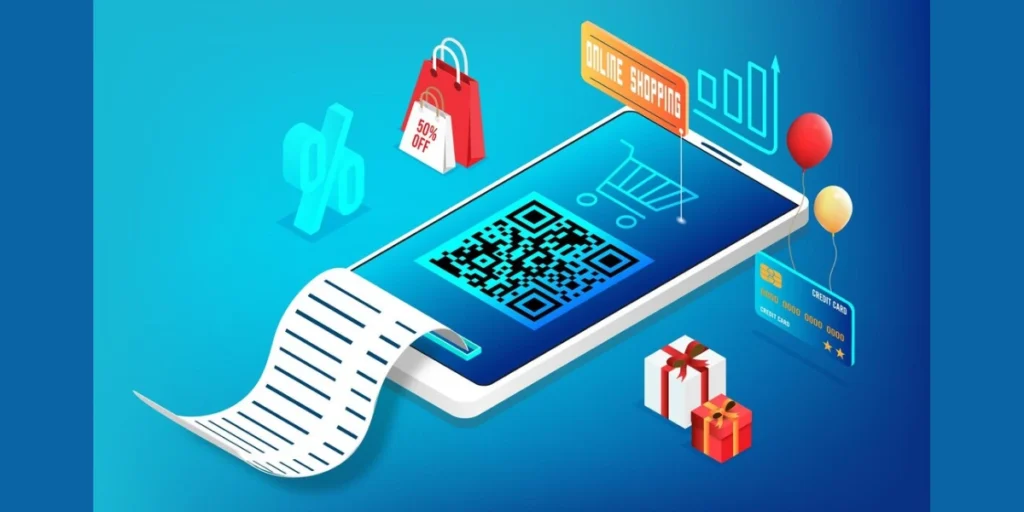
Implementing QRs effectively in marketing strategies requires careful planning and execution to maximize their impact and drive desired outcomes.
Here are some best practices to consider:
1. Provide clear value
Ensure that the content or experience accessed via the QR provides clear value to users. Whether it’s exclusive offers, product information, how-to guides, or entertainment, the content should be relevant, useful, and compelling to encourage QR interaction.
2. Optimize for mobile
Since QRs are primarily scanned using mobile devices, ensure that the linked content is mobile-friendly and optimized for various screen sizes and operating systems. Responsive design, fast loading times, and intuitive navigation enhance the user experience and drive engagement.
3. Placement matters
Strategically place QRs in visible and accessible locations where your target audience is likely to encounter them. Consider high-traffic areas, such as storefronts, product packaging, promotional materials, and digital screens, to maximize exposure and scan rates.
4. Prominently display instructions
Include clear instructions and a compelling call-to-action alongside the QR to prompt users to scan. Use concise and action-oriented language to convey the benefit or incentive of scanning the QR, such as “Scan to Unlock Exclusive Content” or “Scan for Instant Savings.”
5. Test QR Codes before deployment
Before launching your QR campaign, thoroughly test the QRs across different devices, QR scanners, and lighting conditions to ensure they scan reliably. Verify that the linked content is accurate, up-to-date, and functioning as intended to deliver a seamless user experience.
6. Track and analyze performance
Implement tracking mechanisms to monitor QR performance and gather valuable insights into user engagement and behavior. Track metrics such as scan rates, conversion rates, geographic location, and time of scan to evaluate campaign effectiveness and optimize strategies accordingly.
7. Educate and promote awareness
Educate your target audience about QRs and how to scan them effectively. Incorporate QR usage tips, tutorials, or demonstrations in your marketing communications to increase awareness and encourage adoption among consumers.
Brands that trust us:

8. Enhance security and trust
Prioritize security and data privacy when implementing QRs in marketing campaigns. Ensure that the linked content is safe and trustworthy to protect users from potential security risks or fraudulent activities, building trust and credibility with your audience.
9. Iterate and improve
Continuously monitor QR performance metrics and gather feedback from users to identify areas for improvement. Iterate your QR campaigns based on data-driven insights and user preferences to enhance engagement and drive better results over time.
F. FAQs: How to use QR Codes in marketing

1. What are QR Codes, and how do they work in marketing?
QRs are two-dimensional barcodes that can be scanned using a smartphone camera to quickly access digital content, such as websites, videos, or apps.
In marketing, QRs are used to engage consumers, drive website traffic, enhance product packaging, and facilitate contactless transactions.
2. How can I create a QR for my marketing campaign?
You can create one using Scanova. Simply input the desired content or URL you want the QR to link to, customize the design if necessary, and download the generated QR for use in your marketing materials.
3. Where should I place QRs in my marketing materials?
QRs can be placed on various marketing materials, including print ads, posters, flyers, product packaging, business cards, and digital screens.
Ensure that QRs are prominently displayed in visible and accessible locations where your target audience is likely to encounter them.
4. What type of content should I link to my QRs?
The content linked to QRs should provide value and relevance to your target audience. This could include product information, promotional offers, exclusive discounts, instructional videos, customer reviews, or interactive experiences that enhance the user experience and drive engagement.
5. How can I track the performance of my QR marketing campaigns?
Implement tracking mechanisms, such as URL shorteners or QR analytics platforms, to monitor QR performance metrics. Track metrics such as scan rates, conversion rates, geographic location, and time of scan to evaluate campaign effectiveness and optimize strategies accordingly.
6. Are there any best practices to follow when using QRs in marketing?
Yes, some best practices include providing clear value, optimizing for mobile devices, strategically placing QRs, prominently displaying instructions, testing QRs before deployment, tracking performance, educating consumers, enhancing security and trust, and continuously iterating and improving QR campaigns based on data-driven insights.
7. What are some creative ways to use QRs in marketing?
Some creative ways to use QRs in marketing include incorporating them into scavenger hunts, interactive packaging, augmented reality experiences, product demonstrations, virtual tours, digital business cards, and gamified promotions to engage consumers and enhance brand experiences.
8. Is there any security risk associated with using QRs in marketing?
While QRs themselves are not inherently risky, there is a potential security risk if QRs are linked to malicious websites or content. To mitigate this risk, ensure that the linked content is safe, trustworthy, and relevant to your marketing campaign to protect users from potential security threats.
Summing Up
QRs present a versatile and powerful tool for modern marketers to enhance their campaigns and connect with their target audiences effectively.
By following the strategies and best practices outlined in this guide, you can leverage QRs to drive engagement, increase brand visibility, and achieve your marketing objectives.
If you’re still reading, you’ve learned everything about how to use QR Codes in marketing. If you have any questions, let us know in the comments.
